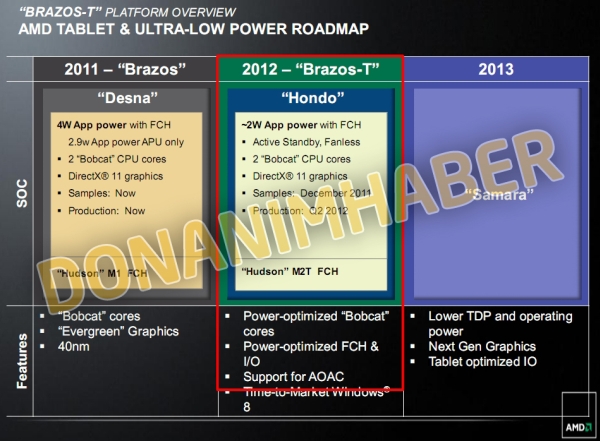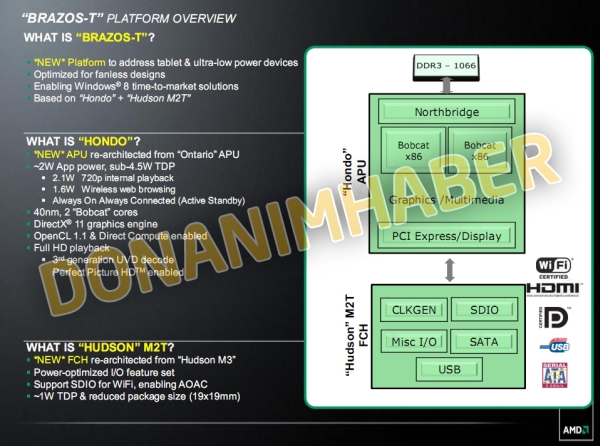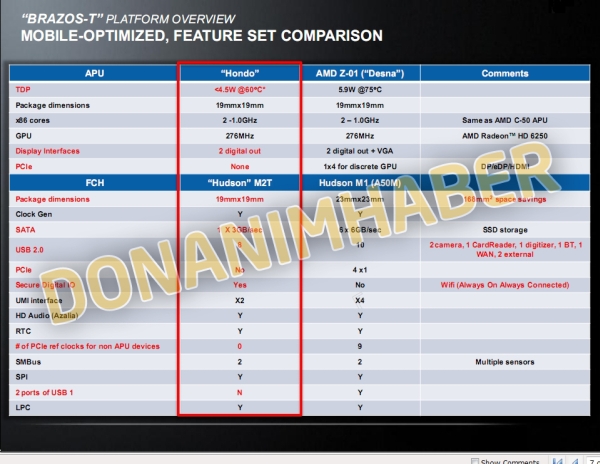You are using an out of date browser. It may not display this or other websites correctly.
You should upgrade or use an alternative browser.
You should upgrade or use an alternative browser.
Llano IGP vs SNB IGP vs IVB IGP
- Thread starter AnarchX
- Start date
It looks like they shaved off a few watts by removing or reducing IO interfaces, and lowering the temperature from 75 to 60.
Removing interfaces is a tradeoff, changing the temperature sounds like moving the goalpost.
Removing interfaces is a tradeoff, changing the temperature sounds like moving the goalpost.
Hondo was presented as a ~5W product from the beginning. Typical application power around 2 W (including chipset) isn't bad.hmm, still 40nm. I`d have hope for 28nm and atleast the same performance at ~half TDP
At Computex rumour was "Krishna APUs releasing in 2012 will bring TDP down to sub-1 watt", but I guess it depends on 28nm maturity and GCN. The fact they're postponing means ether 28nm mass manufacturing wont be ready for a while, or GCN tuning will take longer than expected, or both.Strange I thought by that timeframe (q2/2012) we were supposed to already get the 28nm fusion chips (krishna/wichita) rather than the exact same Ontario chip (tuned for lower power mostly by disabling some i/o).
AMD simply going for safer approach, not to get burned by immature node and new gen graphics. If 4-5W APUs are doing just fine in tablets and netbooks, then 2W will have even more success. They can always speed up launch if everything goes well.
Well if 28nm isn't ready by Q2/2012 that wouldn't bode well for next gen graphics chips... Unless it's just not suitable in that time frame for this kind of chip (e.g. too expensive, too high leakage or whatnot).At Computex rumour was "Krishna APUs releasing in 2012 will bring TDP down to sub-1 watt", but I guess it depends on 28nm maturity and GCN. The fact they're postponing means ether 28nm mass manufacturing wont be ready for a while, or GCN tuning will take longer than expected, or both.
Well for something which more looks like a new stepping rather than a new chip Q2/2012 looks awfully late indeed.AMD simply going for safer approach, not to get burned by immature node and new gen graphics. If 4-5W APUs are doing just fine in tablets and netbooks, then 2W will have even more success. They can always speed up launch if everything goes well.
Well if 28nm isn't ready by Q2/2012 that wouldn't bode well for next gen graphics chips... Unless it's just not suitable in that time frame for this kind of chip (e.g. too expensive, too high leakage or whatnot).
Well for something which more looks like a new stepping rather than a new chip Q2/2012 looks awfully late indeed.
I have no doubt we'll see 28nm Krishna/Witchita APU's by Q2 2012. But you guys are skipping one crucial point. Those slides are all talking about the tablet optimized versions of the APU's which will lag the netbook class APU's by a few quarters due to the need for optimized I/O. Brazos-T is all about time to market, it will be available by Q2 2012 and is right in time for the back to school season and for the Windows 8 launch.
Blazkowicz
Legend
in that light a mature process feels needed for the optimizing and production volume goals.
Good point but I can't see why such minor optimizations would need a full year.I have no doubt we'll see 28nm Krishna/Witchita APU's by Q2 2012. But you guys are skipping one crucial point. Those slides are all talking about the tablet optimized versions of the APU's which will lag the netbook class APU's by a few quarters due to the need for optimized I/O. Brazos-T is all about time to market, it will be available by Q2 2012 and is right in time for the back to school season and for the Windows 8 launch.
Good point but I can't see why such minor optimizations would need a full year.
Me neither. In fact its taken them more than a year for Brazos. They may not have anticipated the use of Brazos for tablets though so it looks like it was a late decision. Possibly they'll be able to offer a tablet variant of Krishna/Witchita quicker
Me neither. In fact its taken them more than a year for Brazos. They may not have anticipated the use of Brazos for tablets though so it looks like it was a late decision. Possibly they'll be able to offer a tablet variant of Krishna/Witchita quicker
It depends if they are disabling and fusing off I/O or actually removing it. It's easy to believe that removing power hungry I/Os like PCI-E could cost you a quarter or two. It saves leakage (compared to merely fusing off), which is probably pretty important.
The problem isn't removing some I/Os, but the subsequent testing, validation, verification, etc. or adding new I/Os (which is even more complicated).
David
http://www.digitimes.com/news/a20110817PD224.html
I've always thought that there was some problem that was reflected in the tdp
I've always thought that there was some problem that was reflected in the tdp
I'd be careful with Digitimes, and perhaps even more so with Monica Chen. There may well be a shortage of Llano parts, but it could be (also) due to other factors, such as high demand, limited volume for some reason, or simply the usual ramp-up that you'd expect with a new process. And then of course there's the fact that Bulldozer is in full production, which limits supply, but it's not selling yet, meaning it makes no dent into demand.
The 28nm bit just sounds like nonsense.
The 28nm bit just sounds like nonsense.



